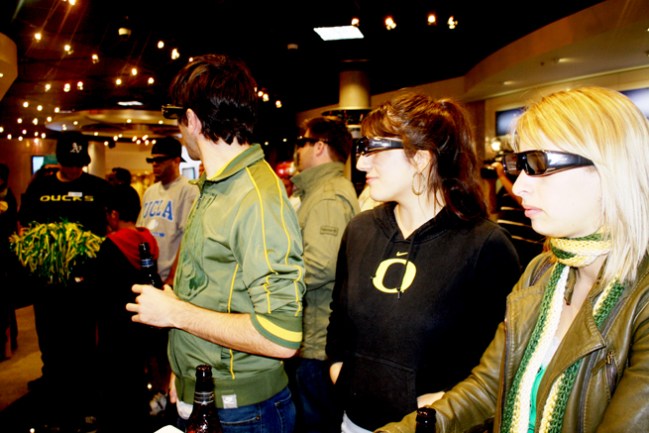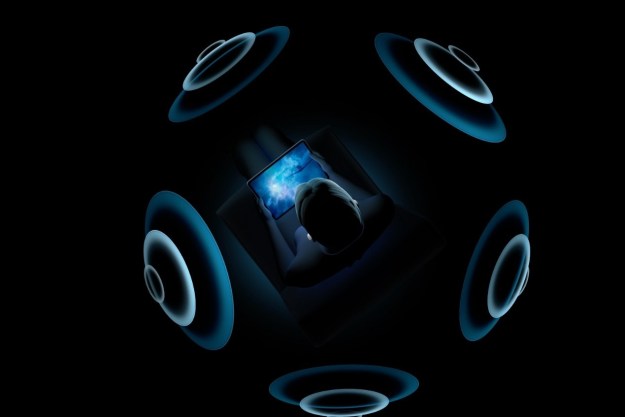
After all the mixed emotions surrounding the introduction of 3D TV and ESPN’s announcement to broadcast in the format, I’ve yet to cast my ballot on watching sports this way. Sure, I’ve spent the extra five bucks to see a Pixar movie or two (I saw Toy Story 3 but not Avatar in 3D – I know, those are some messed up priorities) but I’m a purist when it comes to watching sports. For instance, halftime shows are an interruption I barely tolerate. So when I heard that ESPN would be broadcasting in 3D this year, you could say I was skeptical.
But not so skeptical that I wouldn’t give it a shot. Sony had a viewing party for the 3D broadcast of the Oregon Ducks vs UCLA game, and as both a loyal U of O grad and a tech writer, I went. After taking in an entire game in three dimensions, here’s my breakdown of the pros and cons.
Cons
 Glasses.
Glasses.
I know, it’s the first thing everybody says when they complain about 3D – but they’ve got a point. They’re heavy, dark, and nobody looks cool in them. Also, if you lose the remote as often as I do, think about the challenge of keeping track of these. Not to mention keeping them safe. Got kids? A dog? Are you a human who sometimes spills on objects you shouldn’t? Then be prepared for extra caution when it comes to these suckers.
Positioning.
If I’m watching a game I care about (which to the chagrin of my friends and family, is far too many) there’s a lot of jumping up, getting closer to the screen, pacing nervously, the occasional lewd gesture…and 3D limits this. The glasses are battery-powered and connected with the TV, so changing your line of sight causes them to lose the signal, which can be disorienting. The simple solution is to push the glasses up when you look away, but then, obviously, the screen’s image will be completely skewed when you look back. For optimal viewing, you need to keep focused on the screen and sitting upright – tilting your head too much also causes the connection to be lost.
Should I watch the game or the 3D?
You watch Avatar for the stunning visual experience. You watch a game to see who wins. I found myself amazed by a pass Darren Thomas threw out of bounds because it came at the screen and seemingly, right at me. “So cool,” I thought. Wrong. Not cool. Incomplete passes are not cool. You start paying attention to ESPN’s added graphics and any action coming right at you – but paying less attention to the actual game. It also makes me question how it would translate to basketball, where you’re so much closer to the action and the game moves so much faster.
Pros
It’s probably worth it.
Do I want to watch every game in its entirety in 3D? No. Would I watch part of a game in 3D? Absolutely. It should go without saying that sports in HD are amazing – it’s like getting glasses after years of squinting to barely make out fuzzy objects. So when or if you’re upgrading TVs, it can be assumed you’re going HD, and I’d say it’s worth it to put in the extra money for the option of 3D. The Sony 46-inch Bravia HDTV is $1499.99, and its 3D version is $1,999.99. So if you’re going to drop serious cash on upgrading your TV anyway, why not go for it?
It’s really cool.
There’s not a lot more to say than that. It is really fun to see your team in 3D, maybe not for two or three hours, but definitely for awhile. Sure it’s a novelty, but an enjoyable one. As much as anyone loves sports, there are plenty of instances in a game that aren’t action-packed, and 3D absolutely makes those moments a lot more fun.
Sports are theater.
I know I said I’m a purist, but I should probably get on board with sports as theater. There’s more fan involvement in the drama of players’ lives, people want more from game coverage, and broadcasters know this. TV isn’t just a functional tool for me to get the end score, and that’s certainly not the direction it’s going. At the Sony event, whenever I took my glasses off and watched on the HDTV, I wondered what I was missing out on. 3D TV might not enhance every aspect of the game, but sports will be broadcast to enhance 3D TV, so I might as well enjoy it.
Editors' Recommendations
- You Asked: 3D VR, QDEL technology, and TV size vs. quality
- Samsung, Google are attacking Dolby Atmos’ monopoly on 3D sound, and it’s going to get ugly
- I saw Sony’s 2023 TVs, and I think this model might be the best TV of the year
- LG’s 42-inch LX3 OLED TV can bend when you want it to
- 3D-printed eartips could mean way more comfortable and better-sounding earbuds


